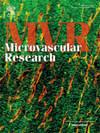The influence of cuff location on the oxygenation and reperfusion of the foot during ischemic preconditioning: A reliability study
IF 2.7
4区 医学
Q2 PERIPHERAL VASCULAR DISEASE
引用次数: 0
Abstract
Ischemic preconditioning (IPC) involves the application of occlusion cycles, typically prior to exercise. IPC is commonly applied at the arm or thigh for improving exercise performance, which can be combined with near-infrared spectroscopy (NIRS) to assess the microcirculation and tissue oxygenation. Despite the use of NIRS during IPC, few studies have investigated the reliability of NIRS during lower limb IPC with no relevant publications investigating IPC at the ankle. Therefore, the purpose of this study was to investigate the intra-session reliability in the NIRS measurements during repeated IPC at the thigh, ankle and arm. Eighteen participants volunteered. IPC was applied at the thigh (220 mmHg), ankle (individualized arterial occlusion pressure: 212 ± 24 mmHg) and arm (220 mmHg) in a randomized order involving 3 repeated cycles of 5-min occlusion and reperfusion, within a session. NIRS recorded tissue oxygen saturation (SO2), oxygenated (O2Hb) and deoxygenated hemoglobin (HHb) at the abductor hallucis muscle. Reliability was assessed using intraclass correlation coefficients. For all NIRS measurements assessed, there was excellent reliability (All ICC > 0.94) for the average, minimum and maximum values. The results indicate that IPC can successfully be applied at the ankle, offering reliable measures between three repeated occlusions within a session.
在缺血预处理中袖带位置对足部氧合和再灌注的影响:一项可靠性研究
缺血预处理(IPC)涉及闭塞循环的应用,通常在运动之前。IPC通常应用于手臂或大腿,以提高运动表现,可与近红外光谱(NIRS)结合评估微循环和组织氧合。尽管在IPC期间使用了近红外光谱,但很少有研究调查近红外光谱在下肢IPC期间的可靠性,没有相关的出版物调查踝关节的IPC。因此,本研究的目的是研究在大腿、脚踝和手臂重复IPC期间NIRS测量的会话内可靠性。18名参与者自愿参加。IPC应用于大腿(220 mmHg)、脚踝(个体化动脉闭塞压:212±24 mmHg)和手臂(220 mmHg),随机顺序为3个重复周期,在一个疗程内进行5分钟的闭塞和再灌注。近红外光谱记录了幻觉外展肌组织氧饱和度(SO2)、氧合血红蛋白(O2Hb)和脱氧血红蛋白(hbb)。用类内相关系数评估信度。对于所有评估的近红外测量,都有极好的可靠性(all ICC >;0.94)表示平均值、最小值和最大值。结果表明,IPC可以成功地应用于踝关节,在一个疗程内提供三次重复闭塞之间的可靠测量。
本文章由计算机程序翻译,如有差异,请以英文原文为准。
求助全文
约1分钟内获得全文
求助全文
来源期刊

Microvascular research
医学-外周血管病
CiteScore
6.00
自引率
3.20%
发文量
158
审稿时长
43 days
期刊介绍:
Microvascular Research is dedicated to the dissemination of fundamental information related to the microvascular field. Full-length articles presenting the results of original research and brief communications are featured.
Research Areas include:
• Angiogenesis
• Biochemistry
• Bioengineering
• Biomathematics
• Biophysics
• Cancer
• Circulatory homeostasis
• Comparative physiology
• Drug delivery
• Neuropharmacology
• Microvascular pathology
• Rheology
• Tissue Engineering.
 求助内容:
求助内容: 应助结果提醒方式:
应助结果提醒方式:


